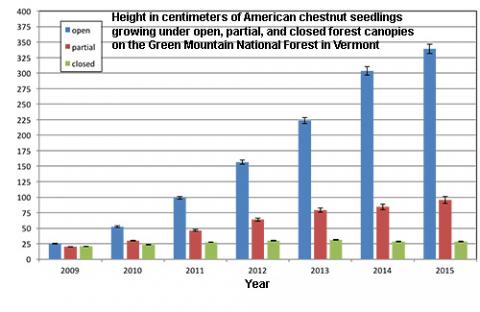Using Silvicultural Management and Genetic Selection to Assist in the Restoration of American Chestnut to the Northern Forest

Scientists are breeding American chestnut to restore the tree to the landscape and increase its tolerance to chestnut blight – a disease that removed this species from native forests. Chestnuts in the north face a second challenge – freezing injury that kills shoots and alters tree form. NSRC researchers examined how genetic selection and silvicultural treatment can improve winter hardiness and growth necessary for American chestnut restoration in the Northern Forest.
Researchers measured shoot winter injury and growth of American chestnut, Chinese chestnut, and red oak in a plantation on the Green Mountain National Forest in Vermont. The planting incorporates 13 American chestnut sources from southern, central, and northern portions of the species’ range grown together with 2 Chinese chestnut and 2 red oak sources in a replicated design under three levels of silvicultural treatments (open, partial, and closed forest canopies).
Chinese chestnut had greatest early growth but was most vulnerable to freezing injury. American chestnut had the greatest long-term growth, and winter injury levels were similar to native competitor red oak. Initially, American chestnut plants from cold temperature zones grew less and experienced less winter shoot injury than chestnuts from warm and moderate temperature zones. Differences among temperature zones diminished over time. Growth was consistently greatest in the open, with modest growth under partial canopy and lowest growth under closed canopies. Despite some vulnerability to freezing injury, once blight-resistant stock is readily available, American chestnut has a great potential for growth and carbon sequestration in the Northern Forest. Silvicultural management to limit shading may be needed to realize maximum growth.
